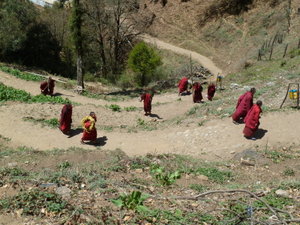Advertisement

 Tango Gompa
Tango Gompa
Monks along trailWednesday morning, we drove about 45 minutes outside of Thimphu to Tango Gompa. En route, we stopped to visit a magnificent painting of Padmasambhava on a rock face along the roadside. It was, perhaps 15 feet in diameter and included a beauty array of colors. Below it, a small building sheltered 2 huge prayer wheels which were spinning continuously, powered by a mountain stream running through the structure. As the prayer wheels turned, they rang bells at each revolution. The entire setting was magical.
The trail to Tango Gompa was about a 2 hour hike up the mountainside, scattered with red rhododendron blossoms and large trees growing in all sorts of interesting angles, hanging off the trail edge. A Spanish moss type of plant draped from many trees. We took it slow and steady as we were feeling the altitude. There were a few simple wood structures, draped with colorful prayer flags, as rest stops along the way. Toward the top, we passed a chorten (same as stupa in India) where a group of monks were performing rituals. When we finally approached the summit, we emerged from the trees to the sight of an enormous dzong, a fortress/monastery built in

 Tango Gompa
Tango Gompa
View of gompa and valleythe 1600s and styled with exquisitely beautiful, painted woodworking and intricate carving around the windows, doors and under the rooflines. The gate leading into the monastery was similarly decorated. Even once the dzong was in view, we still had a climb ahead of us until we actually emerged onto the parapets with the most spectacular views down the valley and surrounding mountains. Breathtaking!
Inside, we were able to join the monks in their prayers and experienced the full auditory blend of chanting, the big long horns, the drums, the bells, the conchshell, and short brass horns, all in a space where not a single square inch was left plain or unadorned. All the skills we witnessed the young students learning at the National Institute for Arts and Crafts were in evidence. The walls were intricately painted with images of the Buddha and other deities, and yet at the same time, were covered with beautifully embroidered hangings. Other embroiderys hung from the ceiling which was also painted with innumerable patterns, symbols, and images. The huge painted statues of the Buddha, Guru Rinpoche (Padmasambhava), and a 3rd man (revered as the person who united Bhutan in the 1600s and built the

 Downtown Thimphu
Downtown Thimphu
The golden Buddha overlooks the cityfirst dzongs or fortresses) held space at one end of the room. The floors were the wideboard lupine. The monks sat on long carpets woven in patterns that defined the space for each monk. They wore the familiar deep red robes. The room vibrated with the whole mix of visual and auditory input and we were ineffably moved. After the prayer experience, we were invited for tea and bisciuts in another room, much smaller, but still exquisitely decorated. The classic "milk tea" was delicious.
This monastery is also a university where young monks train for 9 years before going out to other monasterys. Later, after a beautiful hike back down the mountain, and continuing by car, we passed another monastery high up on a mountain. Our monk guide, Rinchen, told us that this monastery is where he recently completed his traditional silent retreat of 3 years, 3 months, and 3 days.
In Bhutan, the king and the main religious leader are considered equal. They sit at the same levels in the temples and are both respected for their different spheres. After lunch back in Thimphu, we headed east to Dochula Pass where we visited another temple illustrating their

 Thimphu's only traffic control
Thimphu's only traffic control
The traffic light experiment proved wildly unpopular!2 equal seats. Every temple is styled and decorated with the same exquisite wood and textile crafts. At the foot of the Dochula temple stand the 108 chortens (stupas in India), built by the Queen of Bhutan in 2003 to protect the country during the conflict with Indian insurgents in the south.
The temple and chortens all sit on the top of the world for here, at Dochula Pass, we have a 180 degree view of the snow-capped Himalayas. We were all in awe. And then to discover that our night's lodging is here as well! Settled into our hotel, we enjoyed a perfect evening of deep conversation and a delicious dinner, all overlooking the Himalayas. Our clocks are set for 5am to arise and experience the sunrise in this magical place...
Advertisement
Tot: 0.117s; Tpl: 0.013s; cc: 9; qc: 44; dbt: 0.0549s; 1; m:domysql w:travelblog (10.17.0.13); sld: 1;
; mem: 1.1mb

 Tango Gompa
Tango Gompa
 Tango Gompa
Tango Gompa
 Downtown Thimphu
Downtown Thimphu
 Thimphu's only traffic control
Thimphu's only traffic control